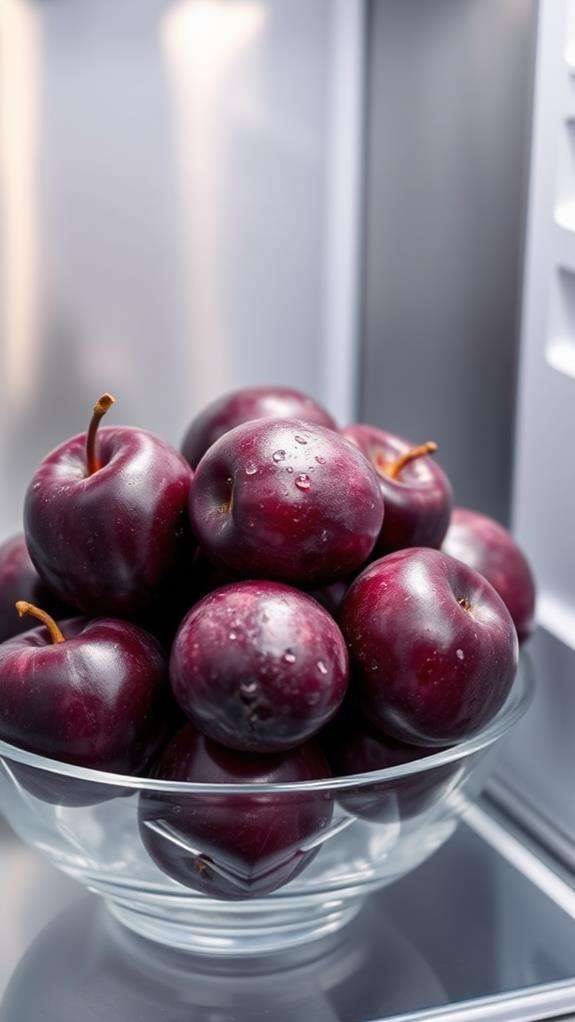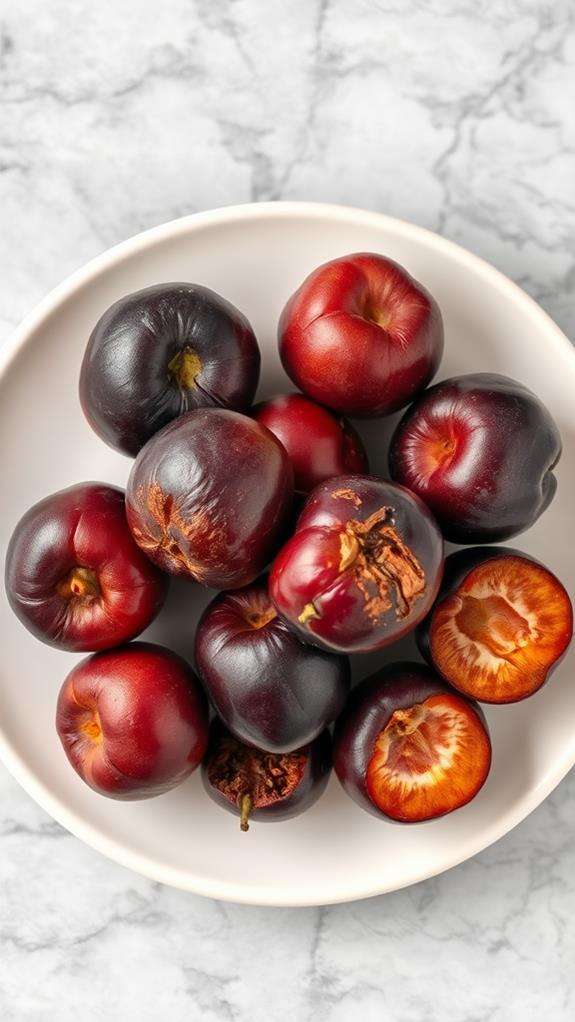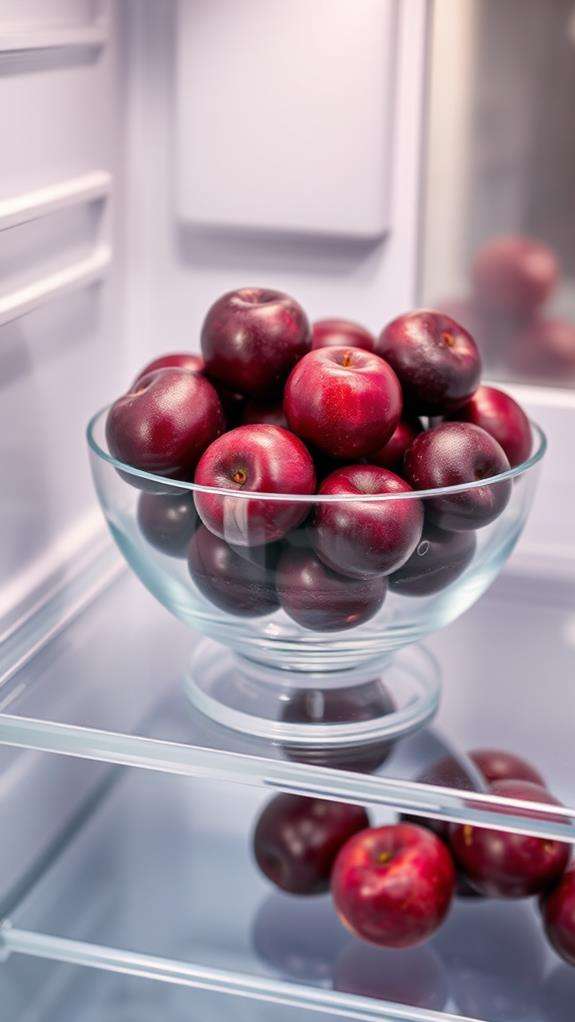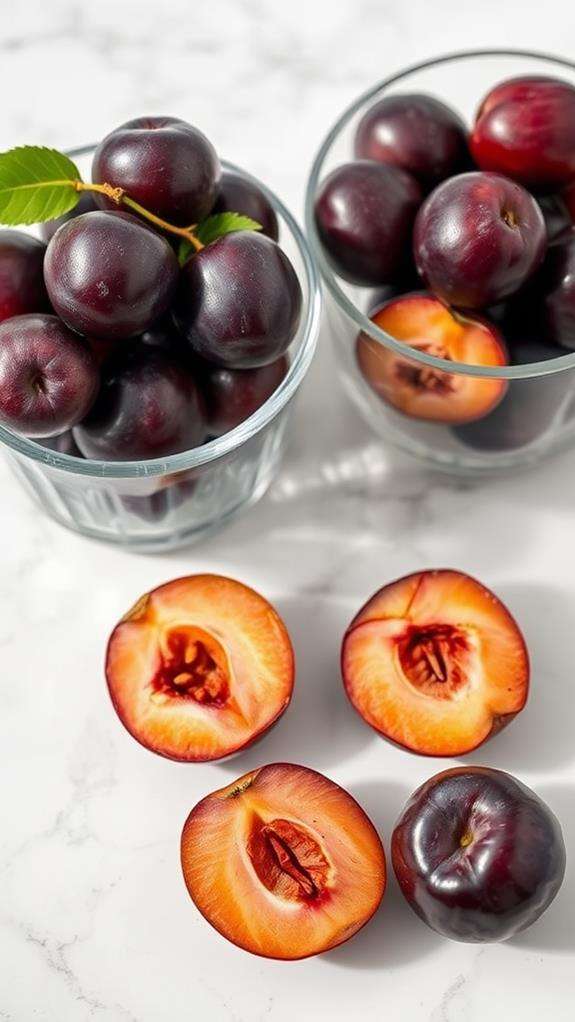How Long Do Plums Last in the Fridge
Your plums will last up to two weeks in the refrigerator when stored properly at 40°F (4°C) in the crisper drawer. To maximize freshness, keep them unwashed in a paper bag with small holes or a breathable container, and arrange them in a single layer to prevent bruising. Cut plums have a shorter lifespan of 1-2 days, even when refrigerated, while whole unripe plums can maintain quality for the full two-week period. Monitor your plums daily for signs of spoilage like mold, soft spots, or fermented smells, and remove any damaged fruits immediately. Understanding proper storage techniques can considerably extend your plums' shelf life.
This post may contain affiliate links. If you make a purchase through these links, I may earn a commission at no additional cost to you. Additionally, portions of this post may be generated using artificial intelligence (AI) technology. While we strive for accuracy, please be aware that AI-generated content may not always be perfect and should be fact-checked when necessary.
The Spatula Scoops
- Properly stored whole plums can last up to two weeks in the refrigerator when kept at 40°F (4°C).
- Cut plums should be consumed within 1-2 days, even when refrigerated in airtight containers.
- Unripe plums maintain quality longest, lasting up to two weeks when stored at 32-35°F (0-2°C).
- Fully ripe plums typically stay fresh for 3-5 days in the refrigerator's crisper drawer.
- Storage life depends on initial ripeness, with firm plums lasting 3-5 days longer than fully ripened ones.
Proper Storage Methods for Plums

For ideal freshness, store plums in your refrigerator's crisper drawer at around 40°F (4°C). You'll want to keep them unwashed and arrange them in a single layer, avoiding any overlap that could create pressure points and lead to premature spoilage. If your plums aren't quite ripe, let them mature at room temperature first, then transfer them to the fridge once they yield slightly to gentle pressure.
To maximize shelf life, don't store your plums in plastic bags, as trapped moisture can accelerate decay. Instead, place them in a paper bag with small holes or a breathable produce container that allows proper air circulation. You'll also want to keep them away from strong-smelling foods, as plums can easily absorb other odors. Check your stored plums daily and remove any that show signs of damage or mold, as these can quickly affect neighboring fruit.
For commercial storage, you can use perforated plastic liners specifically designed for stone fruits, but for home storage, simpler methods work just fine. Remember to handle your plums gently, as bruising will considerably reduce their storage life.
Signs of Plum Spoilage

Even with proper storage, you'll need to monitor your plums for signs of spoilage. When examining your plums, look for obvious visual indicators like mold growth, which typically appears as fuzzy white, green, or blue spots on the fruit's surface. You'll also want to check for dark or soft spots, which indicate bacterial growth and tissue breakdown.
Pay attention to your plums' texture, as it's a reliable indicator of freshness. When you gently press the fruit, it should give slightly but maintain some firmness. If your plums feel mushy, excessively soft, or have wrinkled skin, they're past their prime. A plum that's too hard, however, isn't spoiled – it just needs more time to ripen.
Your nose can also detect spoilage. Fresh plums should have a sweet, fruity aroma. If you notice any fermented, sour, or unusual smells, it's time to discard the fruit. Additionally, check for any liquid seepage or sticky residue at the bottom of your storage container, as this often indicates that the plums are breaking down and beginning to ferment. When in doubt about a plum's freshness, it's better to discard it than risk consuming spoiled fruit.
Extending Plum Shelf Life

While proper storage is essential, several additional strategies can help maximize your plums' shelf life in the refrigerator. Begin by selecting plums that are free from blemishes and slightly firm to the touch, as these will last longer than fully ripened ones. Don't wash your plums until you're ready to eat them, since excess moisture can accelerate spoilage.
You'll want to store your plums in the crisper drawer, but don't just toss them in. Place them in a perforated plastic bag or container that allows for proper air circulation. If you've bought unripe plums, let them ripen at room temperature first, then transfer them to the fridge. Keep them away from strong-smelling foods, as plums can absorb odors easily.
For ideal freshness, arrange your plums in a single layer rather than stacking them. This prevents bruising and allows you to monitor each fruit's condition. If you notice one plum starting to overripen, remove it immediately to prevent it from affecting the others. These preservation techniques can extend your plums' refrigerator life from 3-5 days to up to two weeks.
Storing Cut vs. Whole Plums

Storage methods differ markedly between cut and whole plums. When you're storing whole plums, you'll want to keep them unwashed in a plastic bag with small holes for ventilation. They'll last 3-5 days at room temperature or up to two weeks in your refrigerator's crisper drawer when stored properly.
Cut plums require different handling altogether. Once you've sliced a plum, you'll need to store it in an airtight container or wrap it tightly in plastic wrap to prevent oxidation. The exposed flesh will start to brown and deteriorate quickly, so you should consume cut plums within 1-2 days, even when refrigerated. If you're planning to store cut plums, you can sprinkle them with a small amount of lemon juice to help prevent browning.
For ideal freshness, you'll want to place cut plums in the main compartment of your refrigerator, not the crisper drawer, at a temperature between 34-40°F (1-4°C). Remember that any signs of mold, unusual softness, or off-putting odors mean it's time to discard the fruit, regardless of how long you've stored it.
Ripeness and Storage Duration

The ripeness level of your plums plays a critical role in determining how long they'll last in the fridge. If you're storing firm, slightly underripe plums, you can expect them to last 3-5 days longer than their fully ripened counterparts. Unripe plums will maintain their quality for up to two weeks when refrigerated at 32-35°F (0-2°C).
Fully ripe plums, which yield slightly to gentle pressure and have reached their peak sweetness, typically stay fresh for 3-5 days in the refrigerator. You'll know they're ready for cold storage when they emit a sweet aroma and have developed their characteristic deep color. If your plums are very soft or showing signs of overripeness, you should consume them within 1-2 days, even with refrigeration.
To maximize storage duration, you'll want to inspect your plums regularly for signs of deterioration. Watch for wrinkled skin, excessive softness, or dark spots, which indicate your plums are past their prime. Remember that temperature fluctuations can notably impact storage life, so keep your refrigerator's temperature consistent and store plums away from the door where temperatures tend to vary.
Frequently Asked Questions
Can Frozen Plums Be Used to Make Jam After Thawing?
Yes, you can definitely use frozen plums to make jam after thawing. Just like Sarah, a home canner in Vermont, who froze her summer plums and made delicious preserves in winter, you'll find that frozen plums maintain their jamming properties. When you're ready, thaw them completely in the refrigerator, drain any excess liquid, and proceed with your favorite jam recipe. You'll notice the plums are softer after freezing, which can actually make the jam-making process easier.
Do Different Plum Varieties Have Different Storage Requirements?
Different plum varieties do have distinct storage requirements. You'll find that Japanese plums, which are typically softer and juicier, need more careful handling and should be stored at slightly cooler temperatures (around 32-35°F). European plums, being firmer, can tolerate slightly warmer temperatures (35-40°F). Both types benefit from moderate humidity (90-95%), but you'll need to check Japanese plums more frequently for signs of overripening or spoilage.
Will Storing Plums Near Other Fruits Affect Their Taste?
Yes, storing plums near other fruits can affect their taste because many fruits release ethylene gas, which speeds up ripening. You'll want to keep your plums away from apples, bananas, and pears, as they're high ethylene producers. If you'd like your plums to ripen faster, you can purposely store them near these fruits. For the best flavor preservation, store your plums separately from other produce in your fridge's crisper drawer.
Can You Eat Plum Skin That Has Developed a Whitish Coating?
Just like how frost on a winter window isn't harmful, that whitish coating on your plum skin (known as "bloom" or "wax bloom") is perfectly safe to eat. It's actually a natural protective layer that helps preserve the fruit. You don't need to wash it off, but if you prefer, you can rinse the plum before eating. The bloom consists of natural waxes and isn't a sign of spoilage.
What Containers Work Best for Storing Dried Plums Long-Term?
You'll want to store your dried plums in airtight containers that block light and moisture. Glass jars with tight-fitting lids, food-grade plastic containers, or vacuum-sealed bags work best. For maximum freshness, you'll find that Mason jars with rubber seals are particularly effective. If you're storing large quantities, consider using food-grade buckets with gamma seal lids. Just make sure whatever container you choose is completely clean and dry first.





